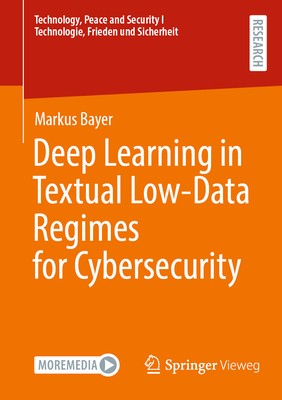
- We will send in 10–14 business days.
- Author: Markus Bayer
- Publisher: Springer Vieweg
- ISBN-10: 3658487771
- ISBN-13: 9783658487775
- Format: 14.8 x 21 x 2.1 cm, mīksti vāki
- Language: English
- SAVE -10% with code: EXTRA
Deep Learning in Textual Low-Data Regimes for Cybersecurity (e-book) (used book) | bookbook.eu
Reviews
Description
In today's fast-paced cybersecurity landscape, professionals are increasingly challenged by the vast volumes of cyber threat data, making it difficult to identify and mitigate threats effectively. Traditional clustering methods help in broadly categorizing threats but fall short when it comes to the fine-grained analysis necessary for precise threat management. Supervised machine learning offers a potential solution, but the rapidly changing nature of cyber threats renders static models ineffective and the creation of new models too labor-intensive. This book addresses these challenges by introducing innovative low-data regime methods that enhance the machine learning process with minimal labeled data. The proposed approach spans four key stages:
Data Acquisition: Leveraging active learning with advanced models like GPT-4 to optimize data labeling.Preprocessing: Utilizing GPT-2 and GPT-3 for data augmentation to enrich and diversify datasets.
Model Selection: Developing a specialized cybersecurity language model and using multi-level transfer learning.
Prediction: Introducing a novel adversarial example generation method, grounded in explainable AI, to improve model accuracy and resilience.
EXTRA 10 % discount with code: EXTRA
The promotion ends in 23d.03:22:18
The discount code is valid when purchasing from 10 €. Discounts do not stack.
- Author: Markus Bayer
- Publisher: Springer Vieweg
- ISBN-10: 3658487771
- ISBN-13: 9783658487775
- Format: 14.8 x 21 x 2.1 cm, mīksti vāki
- Language: English English
In today's fast-paced cybersecurity landscape, professionals are increasingly challenged by the vast volumes of cyber threat data, making it difficult to identify and mitigate threats effectively. Traditional clustering methods help in broadly categorizing threats but fall short when it comes to the fine-grained analysis necessary for precise threat management. Supervised machine learning offers a potential solution, but the rapidly changing nature of cyber threats renders static models ineffective and the creation of new models too labor-intensive. This book addresses these challenges by introducing innovative low-data regime methods that enhance the machine learning process with minimal labeled data. The proposed approach spans four key stages:
Data Acquisition: Leveraging active learning with advanced models like GPT-4 to optimize data labeling.Preprocessing: Utilizing GPT-2 and GPT-3 for data augmentation to enrich and diversify datasets.
Model Selection: Developing a specialized cybersecurity language model and using multi-level transfer learning.
Prediction: Introducing a novel adversarial example generation method, grounded in explainable AI, to improve model accuracy and resilience.


Reviews